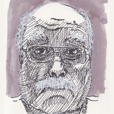-
Posts
905 -
Joined
-
Last visited
Reputation Activity
-
 shipmodel got a reaction from druxey in Swan 42 by shipmodel - FINISHED - one-design racing yacht
shipmodel got a reaction from druxey in Swan 42 by shipmodel - FINISHED - one-design racing yacht
Hi all -
The past week has been spent refining the cockpit area of the upper hull. The first photo is of an actual yacht focusing on the cockpit. You can see the compound planes and angles that form the integral bench, the seat back and the seatings for the two aft winches on each side. The two guys in khaki shorts are sitting on the tops of the seat backs with their feet on the benches. The aft cabin bulkhead is composed of several planes that meet at odd angles, with curves and fillets of assorted radius where they meet.
You can see in the second photo how this has been carved into the wood. No secrets here, just files, sanding blocks with rounded corners, and a sharp #10 blade for the corners.
Once the planes were defined, the companionway was attacked. You can see its size and shape in the third photo. It will be modeled closed.
Alongside of the companionway roof are a pair of shallow angled ramps that lead down and forward. At the front end of each there is a small raised lip, and a flat tunnel which extends under the cabin roof to a similar carved depression at the base of the mast. On the ramp sit five line brakes for the various halyards and other rigging lines. You can see this in the fourth photo. In use the lines run down the mast, through blocks at the base, then into the tunnells leading aft, up and through the line brakes, then to the winches further aft. I saw the boat in drydock so the lines weren't there, which actually made getting a view of the details a little easier.
I drew out the shape and location of the companionway on the wood, then started cutting down from the top about 1/8" to make the socket where a plate of smoked plastic will ultimately sit. It was roughly machined out using a milling bit in the miniature Dremel drill press (I'll get that Unimat one day). Smaller bits were used to progressively approach the pencil lines. Using a widely flared bitt I undercut the top, then used files to refine the undercut to match the look of the companionway roof. The vertical face of the companionway was cut down using side cutting bitts in a hand held Dremel. That's why it is rougher than the top face. The roughness will be hidden by the plastic door pieces and metal frames in the final model. The line brake seat on each side was carved out with sharp chisels, the raised lip was added and shaped, and the tunnel mouth was drilled out. After much work photo five is the final carved look of the companionway and line brake seats.
The mast seating area was similarly carved out and the tunnel mouths there were drilled out. Finally, a pair of depressions were carved into the deck on either side of the cabin for small blocks that will be mounted later.
Now the upper hull was temporarily mounted on the lower hull. Holes were drilled through the upper hull at the mast location and through the space where the companionway roof will be. The pieces were clamped together and screws were inserted and tightened, as you can see in photo six.
With the two pieces locked together the sides of the upper hull were sanded to very close to their final shapes and matched to the lower hull. With all of the wood shaping being very close to final, the upper hull was given a coating of wood hardener. After drying, the whole hull was sanded smooth and then the upper hull was unscrewed from the lower. The last two photos are of the first coat of primer on the upper hull. I am using white here because the upper surfaces will be white in the final model.
Much more priming, sanding, re-priming, etc. before the upper hull is ready for me to start on the hatches and other details.
A biento, as the French say.
Dan
-
 shipmodel got a reaction from Overworked724 in Rigging Ratlines
shipmodel got a reaction from Overworked724 in Rigging Ratlines
Hi all -
Here is another tip for tying ratlines -
After you have clipped your lined off card behind the shrouds, put a dot of white paint on each of the outermost shrouds where they cross your lines. Now remove the card. This will give you your horizontal guideline while freeing up access to the back of the shrouds when you tie your knots. After all of the ratlines are done go back and paint over the white dots with black paint. Since the shrouds were tarred, if not the ratlines, this actually results in a more accurate look.
I use clove hitches, myself, even down to 1:96 scale, although I have seen other methods that can be effective. I find them quick to tie and they slide easily up and down the shrouds to get the horizontal look right. At the outermost shrouds I use an overhand loop, which is small and neat, with the tail running down and behind the shroud. The tail pulls outward, so I can adjust the tension on the knots as I go, and helps in avoiding the hourglass problem. I find that using just this overlhand loop is the least obvious once the tail is cut off.
I wrote an article on this method in the Nov/Dec 1989 issue of the old Ships in Scale magazine called "Get the 'Rats' out of your ratlines!" if you have the magazine or the CD.
Dan
-
 shipmodel got a reaction from DORIS in ROYAL CAROLINE 1749 by Doris - 1:40 - CARD
shipmodel got a reaction from DORIS in ROYAL CAROLINE 1749 by Doris - 1:40 - CARD
Doris -
I am somewhat new to the MSW site and still working my way through all of the wonderful build logs. Yours is one of the best. Thank you for sharing your progress. I will follow it with interest.
Be well
Dan Pariser
-
 shipmodel got a reaction from Mark B Snider in Swan 42 by shipmodel - FINISHED - one-design racing yacht
shipmodel got a reaction from Mark B Snider in Swan 42 by shipmodel - FINISHED - one-design racing yacht
Now I turned back to the lower hull. It was refined with templates and progressively finer sanding blocks. After the 400 grit level I sealed it with Minwax Wood Hardener. This product is designed to strengthen rotted wood, but I have found it to be perfect for sealing wood where I want a truly smooth surface. The only drawback is that the wood becomes so hard that it is quite difficult to remove more than just a small amount - don't aske me how I know. I now hold off on using it until I am quite satisfied that I have the proper shape.
After the hardener dried overnight it was sanded smooth to remove the raised grain, and the first coat of Krylon auto primer was sprayed on. This revealed that there were small imperfections where the various lifts had been joined to each other. These were filled by painting the entire lower hull with a thin solution of small-grained plaster. After sanding with a sanding block you can see where the plaster has filled the voids. The plaster was hardened and the next primer coat was applied, then sanded smooth. Ultimately, seven coats of primer were laid on and progressively sanded off with up to 1000 grit paper.
The keel fin and bulb were similarly shaped, hardened, filled and sanded. Because the keel fin is so thin its connection points with the lower hull above and the keel bulb below would be incredibly fragile. I therefore planned for and fitted a steel pin that goes into the hull about 2 inches and down below the keel bulb about the same amount. I don't know how it will be displayed, but this should give them a great deal of flexibility in choosing the mounting for the model.
So here is my progress to date. The three major components - upper hull, lower hull, and keel - can be stacked to see how they line up and to refine them as needed. More as the model develops.
Be well
Dan Pariser
-
 shipmodel got a reaction from MSzwarc in Swan 42 by shipmodel - FINISHED - one-design racing yacht
shipmodel got a reaction from MSzwarc in Swan 42 by shipmodel - FINISHED - one-design racing yacht
Now I turned back to the lower hull. It was refined with templates and progressively finer sanding blocks. After the 400 grit level I sealed it with Minwax Wood Hardener. This product is designed to strengthen rotted wood, but I have found it to be perfect for sealing wood where I want a truly smooth surface. The only drawback is that the wood becomes so hard that it is quite difficult to remove more than just a small amount - don't aske me how I know. I now hold off on using it until I am quite satisfied that I have the proper shape.
After the hardener dried overnight it was sanded smooth to remove the raised grain, and the first coat of Krylon auto primer was sprayed on. This revealed that there were small imperfections where the various lifts had been joined to each other. These were filled by painting the entire lower hull with a thin solution of small-grained plaster. After sanding with a sanding block you can see where the plaster has filled the voids. The plaster was hardened and the next primer coat was applied, then sanded smooth. Ultimately, seven coats of primer were laid on and progressively sanded off with up to 1000 grit paper.
The keel fin and bulb were similarly shaped, hardened, filled and sanded. Because the keel fin is so thin its connection points with the lower hull above and the keel bulb below would be incredibly fragile. I therefore planned for and fitted a steel pin that goes into the hull about 2 inches and down below the keel bulb about the same amount. I don't know how it will be displayed, but this should give them a great deal of flexibility in choosing the mounting for the model.
So here is my progress to date. The three major components - upper hull, lower hull, and keel - can be stacked to see how they line up and to refine them as needed. More as the model develops.
Be well
Dan Pariser
-
 shipmodel got a reaction from Nirvana in Swan 42 by shipmodel - FINISHED - one-design racing yacht
shipmodel got a reaction from Nirvana in Swan 42 by shipmodel - FINISHED - one-design racing yacht
Now I turned back to the lower hull. It was refined with templates and progressively finer sanding blocks. After the 400 grit level I sealed it with Minwax Wood Hardener. This product is designed to strengthen rotted wood, but I have found it to be perfect for sealing wood where I want a truly smooth surface. The only drawback is that the wood becomes so hard that it is quite difficult to remove more than just a small amount - don't aske me how I know. I now hold off on using it until I am quite satisfied that I have the proper shape.
After the hardener dried overnight it was sanded smooth to remove the raised grain, and the first coat of Krylon auto primer was sprayed on. This revealed that there were small imperfections where the various lifts had been joined to each other. These were filled by painting the entire lower hull with a thin solution of small-grained plaster. After sanding with a sanding block you can see where the plaster has filled the voids. The plaster was hardened and the next primer coat was applied, then sanded smooth. Ultimately, seven coats of primer were laid on and progressively sanded off with up to 1000 grit paper.
The keel fin and bulb were similarly shaped, hardened, filled and sanded. Because the keel fin is so thin its connection points with the lower hull above and the keel bulb below would be incredibly fragile. I therefore planned for and fitted a steel pin that goes into the hull about 2 inches and down below the keel bulb about the same amount. I don't know how it will be displayed, but this should give them a great deal of flexibility in choosing the mounting for the model.
So here is my progress to date. The three major components - upper hull, lower hull, and keel - can be stacked to see how they line up and to refine them as needed. More as the model develops.
Be well
Dan Pariser
-
 shipmodel got a reaction from bbrockel in Swan 42 by shipmodel - FINISHED - one-design racing yacht
shipmodel got a reaction from bbrockel in Swan 42 by shipmodel - FINISHED - one-design racing yacht
Now I turned back to the lower hull. It was refined with templates and progressively finer sanding blocks. After the 400 grit level I sealed it with Minwax Wood Hardener. This product is designed to strengthen rotted wood, but I have found it to be perfect for sealing wood where I want a truly smooth surface. The only drawback is that the wood becomes so hard that it is quite difficult to remove more than just a small amount - don't aske me how I know. I now hold off on using it until I am quite satisfied that I have the proper shape.
After the hardener dried overnight it was sanded smooth to remove the raised grain, and the first coat of Krylon auto primer was sprayed on. This revealed that there were small imperfections where the various lifts had been joined to each other. These were filled by painting the entire lower hull with a thin solution of small-grained plaster. After sanding with a sanding block you can see where the plaster has filled the voids. The plaster was hardened and the next primer coat was applied, then sanded smooth. Ultimately, seven coats of primer were laid on and progressively sanded off with up to 1000 grit paper.
The keel fin and bulb were similarly shaped, hardened, filled and sanded. Because the keel fin is so thin its connection points with the lower hull above and the keel bulb below would be incredibly fragile. I therefore planned for and fitted a steel pin that goes into the hull about 2 inches and down below the keel bulb about the same amount. I don't know how it will be displayed, but this should give them a great deal of flexibility in choosing the mounting for the model.
So here is my progress to date. The three major components - upper hull, lower hull, and keel - can be stacked to see how they line up and to refine them as needed. More as the model develops.
Be well
Dan Pariser









